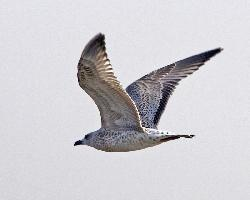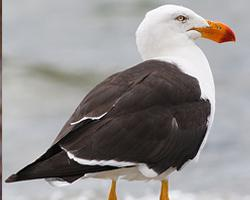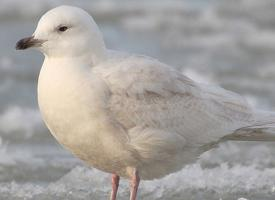
Veszélyeztetettség
| Veszélyeztetett |
Állatleírás
The Vega gull (Larus vegae), a captivating species within the large family of gulls, Laridae, is a bird that captures the interest of birdwatchers and ornithologists alike due to its distinctive characteristics and widespread range. This species, named after the Vega Expedition which was a notable Arctic voyage in the 19th century, exhibits a blend of features that make it both unique and somewhat elusive in the precise categorization within its genus.Physical Description:
The Vega gull is a medium to large bird, with a robust body, long wings, and a fairly heavy bill that is slightly hooked at the tip, typical of many gull species. Adults display a sleek, pale grey back and upperwings, contrasting sharply with their white head, underparts, and tail. The wingtips are black with white spots known as mirrors due to their reflective appearance. One of the distinguishing features of the Vega gull is its bill, which is yellow with a red spot on the lower mandible, a characteristic shared with several other gull species but with subtle differences that can be crucial for identification. The legs are typically pinkish or flesh-colored, and the eyes are surrounded by a thin orbital ring that is usually red or reddish-orange.
Juvenile Vega gulls go through a series of moults before reaching their adult plumage. Initially, they sport a mottled brown appearance, gradually acquiring more of the grey and white adult coloration with each successive moult over a period of about four years until they attain full adult plumage.
Habitat and Range:
The Vega gull has a broad geographical distribution, primarily found in the northern regions of the Pacific Ocean. It breeds in Siberia and northeastern parts of Asia, including areas around the Sea of Okhotsk and the Kamchatka Peninsula. During the winter months, it migrates southwards to spend the colder season along the coasts of Japan, Korea, and eastern China. Some individuals travel as far as Southeast Asia and the northern edges of the Indian subcontinent.
Behavior:
Vega gulls are versatile feeders with a diet that includes fish, insects, small mammals, and carrion. They are also known to scavenge and are often seen following fishing boats for offal, showcasing their opportunistic feeding habits. During the breeding season, they nest in colonies, often on the ground where they lay two to three eggs. Their nests are typically constructed from vegetation and feathers.
Conservation Status:
Currently, the Vega gull is not considered to be under significant threat. It benefits from a wide range and a large, although not thoroughly quantified, population. Like many species of seabirds, it faces threats from pollution, habitat destruction, and climate change, which could impact its food sources and breeding sites in the future.
In summary, the Vega gull (Larus vegae) is a fascinating species with a distinctive appearance and adaptable behaviors that enable it to thrive across a wide range of northern Pacific habitats. Its migration patterns and dietary flexibility illustrate the complex ecological roles that gulls play in coastal and marine environments. As with many wildlife species, understanding and protecting the Vega gull's habitat is crucial for its continued survival and the health of the ecosystems it inhabits.
Hasonló állatok
Új állatfotók
Top 10 állat
- Dolphin gull (Leucophaeus scoresbii)
- Japanese macaque (Macaca fuscata)
- Stone loach (Barbatula barbatula)
- Galápagos tortoise (Geochelone nigra complex)
- Russian tortoise (Testudo horsfieldii)
- Diana monkey (Cercopithecus diana)
- Greek tortoise (Testudo graeca)
- Common flying dragon (Draco volans)
- Moustached guenon (Cercopithecus cephus)
- Galápagos penguin (Spheniscus mendiculus)


